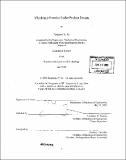| dc.contributor.advisor | Alexander H. Slocum. | en_US |
| dc.contributor.author | Su, Benjamin W | en_US |
| dc.contributor.other | Massachusetts Institute of Technology. Dept. of Mechanical Engineering. | en_US |
| dc.date.accessioned | 2006-05-15T20:42:00Z | |
| dc.date.available | 2006-05-15T20:42:00Z | |
| dc.date.copyright | 2005 | en_US |
| dc.date.issued | 2005 | en_US |
| dc.identifier.uri | http://hdl.handle.net/1721.1/32959 | |
| dc.description | Thesis (S.B.)--Massachusetts Institute of Technology, Dept. of Mechanical Engineering, 2005. | en_US |
| dc.description | Includes bibliographical references (leaf 35). | en_US |
| dc.description.abstract | Inspired by bicycle training rollers, a wheelchair exercise roller (an exercise machine for the application of wheelchair users) was designed from conception of idea to alpha prototype. Background and market data was gathered through research with disabled people, members of disability and rehabilitation centers, and by examining other existing related products. Initial designs were created, and using these designs, functional requirements were set. These functional requirements were used to determine the main product modules (rollers, frame, and ramp) and desired features (simulated natural inertia/forces, varying resistance, tilt feature, etc.) Keeping these in consideration, initial calculations and hands-on research were performed in particular to determine the effect of radial load and RPMs on the bearings. Then, by using test modules built with inline skate bearings, aluminum tube, and wood 2"x 4"s, the initial calculations and research were tested. The results of these tests helped to determine the eventual final design. Solid modeling software (Solidworks 2005) was then used to create various design iterations and make changes as needed. | en_US |
| dc.description.abstract | (cont.) Finally, using the final solid model, a functional prototype was built using 2"x 2" aluminum angle, conveyor belt rollers, and plywood. This prototype was then tested under the conditions the product was originally intended to function under. The result of these tests showed that in the current state, the prototype was not at a level ready to be marketed. The rollers in their current state did not fully simulate the natural inertia and forces felt when rolling on real ground. Also, several desired features had not yet been implemented. However, the prototype did succeed in ultimately showing potential functionality and feasibility of the product. | en_US |
| dc.description.statementofresponsibility | by Benjamin W. Su. | en_US |
| dc.format.extent | 35 leaves | en_US |
| dc.format.extent | 2954032 bytes | |
| dc.format.extent | 2953290 bytes | |
| dc.format.mimetype | application/pdf | |
| dc.format.mimetype | application/pdf | |
| dc.language.iso | eng | en_US |
| dc.publisher | Massachusetts Institute of Technology | en_US |
| dc.rights | M.I.T. theses are protected by copyright. They may be viewed from this source for any purpose, but reproduction or distribution in any format is prohibited without written permission. See provided URL for inquiries about permission. | en_US |
| dc.rights.uri | http://dspace.mit.edu/handle/1721.1/7582 | |
| dc.subject | Mechanical Engineering. | en_US |
| dc.title | Weelchair exercise roller product design | en_US |
| dc.type | Thesis | en_US |
| dc.description.degree | S.B. | en_US |
| dc.contributor.department | Massachusetts Institute of Technology. Department of Mechanical Engineering | |
| dc.identifier.oclc | 62859671 | en_US |
